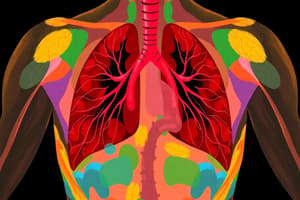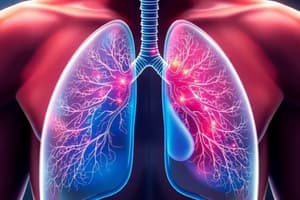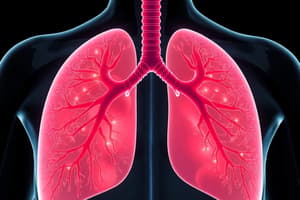Podcast
Questions and Answers
Which of the following is a function of the larynx?
Which of the following is a function of the larynx?
- Protects the trachea (correct)
- Carries air from the trachea into the lung
- Secretes mucus to trap dust and moves mucus up the trachea
- Carries air to the lungs
Which of the following is a function of the trachea?
Which of the following is a function of the trachea?
- Carries air from the trachea into the lung
- Carries air to the lungs (correct)
- Secretes mucus to trap dust and moves mucus up the trachea (correct)
- Protects the trachea
Which of the following is a function of the bronchiole?
Which of the following is a function of the bronchiole?
- Secretes mucus to trap dust and moves mucus up the trachea
- Carries air into the alveolus (correct)
- Carries air to the lungs
- Protects the trachea
Which of the following is a function of the alveolus?
Which of the following is a function of the alveolus?
Which of the following is a function of the capillary?
Which of the following is a function of the capillary?
As air travels from the trachea to the alveoli, the diameter of the respiratory parts decreases.
As air travels from the trachea to the alveoli, the diameter of the respiratory parts decreases.
Which of the following adaptations of the alveoli helps maximize the rate of gaseous exchange?
Which of the following adaptations of the alveoli helps maximize the rate of gaseous exchange?
Which of the following statements accurately describes the relationship between breathing, gaseous exchange, and respiration?
Which of the following statements accurately describes the relationship between breathing, gaseous exchange, and respiration?
What is the primary function of the thin film of moisture surrounding the alveoli?
What is the primary function of the thin film of moisture surrounding the alveoli?
Which of the following is NOT a component of tobacco smoke that has harmful effects on health?
Which of the following is NOT a component of tobacco smoke that has harmful effects on health?
Which of the following is a characteristic of nicotine?
Which of the following is a characteristic of nicotine?
What is the major harmful effect of tar on the alveoli?
What is the major harmful effect of tar on the alveoli?
What is the major harmful effect of carbon monoxide on the body?
What is the major harmful effect of carbon monoxide on the body?
Which of the following is NOT a respiratory disease caused by tobacco smoke?
Which of the following is NOT a respiratory disease caused by tobacco smoke?
Bronchitis is the inflammation of the bronchi, leading to the production of excess mucus, chronic coughing, wheezing, and shortness of breath.
Bronchitis is the inflammation of the bronchi, leading to the production of excess mucus, chronic coughing, wheezing, and shortness of breath.
Emphysema is a condition that weakens and breaks down the alveolar walls, leading to shortness of breath, chronic coughing, and wheezing.
Emphysema is a condition that weakens and breaks down the alveolar walls, leading to shortness of breath, chronic coughing, and wheezing.
Lung cancer is the uncontrolled growth of abnormal cells in the lungs, often caused by exposure to tobacco smoke.
Lung cancer is the uncontrolled growth of abnormal cells in the lungs, often caused by exposure to tobacco smoke.
Flashcards
Larynx function
Larynx function
Protects the trachea.
Trachea function
Trachea function
Carries air to the lungs, secretes mucus to trap dust and moves mucus upward.
Bronchus function
Bronchus function
Carries air from the trachea to a lung.
Bronchiole function
Bronchiole function
Signup and view all the flashcards
Alveolus function
Alveolus function
Signup and view all the flashcards
Capillary function
Capillary function
Signup and view all the flashcards
Pathway of air
Pathway of air
Signup and view all the flashcards
Alveolus surface area
Alveolus surface area
Signup and view all the flashcards
Alveolar wall thickness
Alveolar wall thickness
Signup and view all the flashcards
Alveolar moisture
Alveolar moisture
Signup and view all the flashcards
Capillary network
Capillary network
Signup and view all the flashcards
Oxygen diffusion
Oxygen diffusion
Signup and view all the flashcards
Carbon dioxide diffusion
Carbon dioxide diffusion
Signup and view all the flashcards
Breathing
Breathing
Signup and view all the flashcards
Gaseous exchange
Gaseous exchange
Signup and view all the flashcards
Respiration (aerobic)
Respiration (aerobic)
Signup and view all the flashcards
Nicotine
Nicotine
Signup and view all the flashcards
Tar
Tar
Signup and view all the flashcards
Carbon Monoxide
Carbon Monoxide
Signup and view all the flashcards
Bronchitis
Bronchitis
Signup and view all the flashcards
Emphysema
Emphysema
Signup and view all the flashcards
Lung Cancer
Lung Cancer
Signup and view all the flashcards
Study Notes
Human Respiratory System
- The human respiratory system allows for gaseous exchange.
- Key structures include the larynx, trachea, bronchi, bronchioles, and alveoli.
Respiratory System Parts and Function
- Larynx: Protects the trachea. Secretes mucus to trap dust, and moves mucus up the trachea.
- Trachea: Carries air to the lungs. Secretes mucus to trap dust and moves mucus up the trachea.
- Bronchi: Carry air from the trachea into the lungs
- Bronchioles: Carry air into the alveoli
- Alveoli: Sites of gas exchange.
- Capillary: Carries blood to alveoli; site of gas exchange.
- The airway diameter decreases as air travels to the alveoli.
Alveolus Exchange Surface Adaptations
- Large surface area: Numerous alveoli increase the surface area for faster gas diffusion.
- Thin walls: Alveolar walls are one cell thick, shortening the diffusion path for gases.
- Moisture: A thin film of moisture allows gases to dissolve for efficient diffusion.
- Extensive capillary network: Provides constant blood flow, maintaining a concentration gradient for gas diffusion.
Gaseous Exchange
- Oxygen uptake: Oxygen diffuses from the alveolar space, across the alveolar wall and capillary wall, into the blood.
- Carbon dioxide removal: Carbon dioxide diffuses from the blood, across the capillary wall and alveolar wall, into the alveolar space.
Breathing, Gaseous Exchange, and Respiration
- Breathing: Movement of air in and out of the lungs—caused by pressure changes.
- Gaseous exchange: The absorption of oxygen from the alveolar space into the blood, and removal of carbon dioxide from the blood.
- Respiration (aerobic): The oxidation of glucose—releasing energy, producing water and carbon dioxide. This occurs within the mitochondria.
Tobacco Smoke and Its Effects
- Tobacco smoke contains nicotine, tar, and carbon monoxide, all harmful toxins.
- Nicotine: Highly addictive stimulant that increases heart rate and blood pressure. It can lead to heart disease and blocked arteries.
- Tar: Reduces the efficiency of gaseous exchange and causes lung damage (bronchitis, emphysema).
- Carbon monoxide: Binds to hemoglobin in blood, reducing its ability to transport oxygen. This can lead to oxygen deprivation in tissues.
Respiratory Diseases
- Bronchitis: Inflammation of the bronchi, causing mucus buildup and reduced air flow.
- Emphysema: Weakening/breakdown of alveolar walls, reducing surface area for gas exchange.
- Lung cancer: Uncontrolled growth of abnormal cells (tumors) in the lungs.
Studying That Suits You
Use AI to generate personalized quizzes and flashcards to suit your learning preferences.
Related Documents
Description
This quiz covers the essential parts and functions of the human respiratory system. It highlights key structures such as the larynx, trachea, bronchi, bronchioles, and alveoli, as well as the adaptations of alveoli for efficient gas exchange. Test your knowledge on how these components work together to facilitate respiration.





